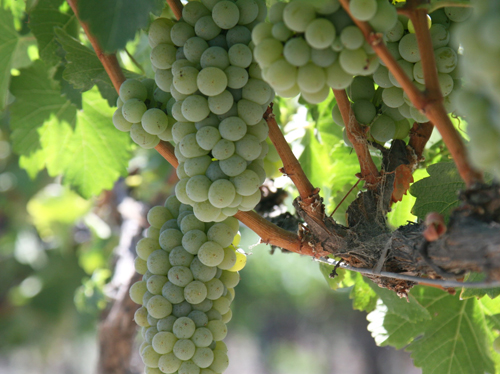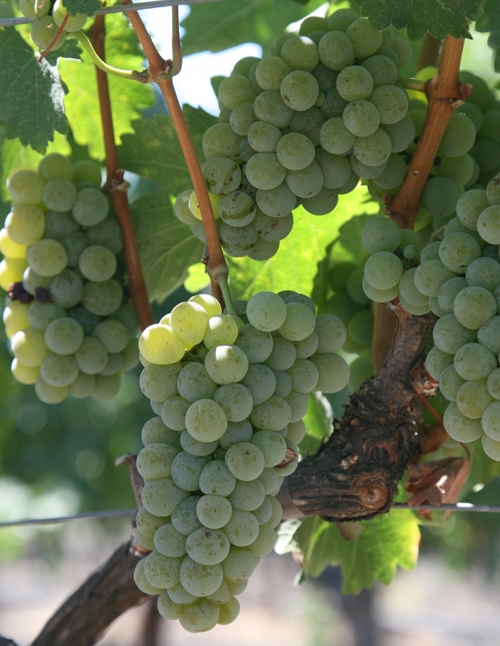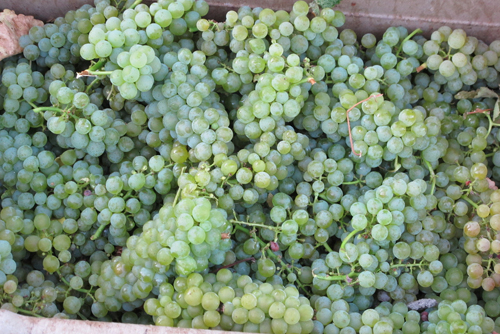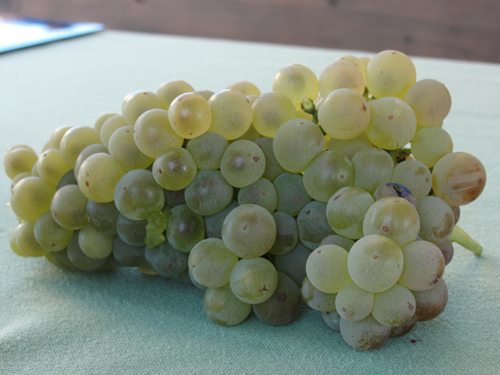Sauvignon Blanc grape variety
Sauvignon Blanc is one of the best known and most widespread technical grapes used worldwide for the production of white wines. It originates from the valley of the French river Loire and the province of Bordeaux, belonging to the Western European ecological-geographical group. The name is derived from the French words sauvage (wild) and blanc (white). According to genetic studies carried out in 2006, it was found that the parents of Sauvignon Blanc are the Chenin Blanc and Traminer varieties. Crossing them, most likely, happened spontaneously.

Over the centuries that have passed since its appearance and introduction into culture in its homeland, the variety has gained significant distribution both in Europe and on other continents. At present, in terms of total area occupied, it ranks second in the world after Chardonnay among white varieties. The most significant tracts of Sauvignon are concentrated in France. On the European continent, this grape is also popular in Germany, Italy, Austria, Spain, Switzerland, Slovenia, Czech Republic, Serbia, Croatia, Bulgaria, Romania, Hungary, Moldova, etc. Recently, the production of Sauvignon Blanc and wine from it in the countries the so-called "New World" - Australia, New Zealand, South Africa, Chile, USA and Canada. Moreover, in some countries, for example in New Zealand, winemakers achieve such remarkable results when working with this variety that they even cause envy and attempts to imitate on the part of their French colleagues.
The variety is called differently in different regions. As a result, the list of synonyms is already several dozen names. Over the long history of its existence, it has acquired a number of clones with slightly different characteristics, the most famous of which are Sauvignon Gris, Sauvignon Noir and Sauvignon Violet. In addition, he is one of the parents of another fantastically popular wine grape variety - Cabernet Sauvignon.
The variety shows itself perfectly in cool areas, where it acquires a characteristic freshness and a very rich bouquet of aromas. In hot climates, it accumulates too much sugar, which makes dry wines heavy, therefore, dessert drinks are made from it. Often Sauvignon Blanc is used in a blend with other wine materials, which greatly enriches their taste and bouquet.

From an agrotechnical point of view, he, like most purebred representatives of the noble European-Asian grape species, is quite demanding on growing conditions and caring for him. It has low frost resistance and is susceptible to fungal diseases.
Agrobiological characteristics of the variety
The growth vigor of the bushes is average. The crown of a young shoot is greenish-white, pink edging is noticeable along the edge of the leaves, the surface is covered with light cobweb pubescence. Leaves of Sauvignon blanc are funnel-grooved, round, medium-sized, three- or five-lobed, strongly dissected. The leaf blade is roughly tuberous, the reverse side has a dense bristly-cobweb pubescence. The upper incisions are deep, mostly closed with an oval-ovate lumen, the lower ones are shallower in depth, they are both open and closed. The petiole notch is of two types: closed with a narrow elliptical lumen, or open lyre-shaped with a rounded bottom. The teeth along the edge of the leaf are large, dome-shaped or triangular with a rounded apex. The flowers are bisexual, pollination is good and stable over the years. Vine bushes planted on damp, heavy soils may have a significant drawback - shedding of flowers. The maturation of the one-year growth is not bad. Ripe shoots acquire a reddish-brown color. Leaves are yellow in autumn.

The bunches of the variety are small or medium in size.Their length on average ranges from 10-13 cm, width - 6-10 cm. The shape of the Sauvignon Blanc brushes is cylindrical, sometimes with a wing, the density is very high. Average weight 70-125 grams. The comb is very short. The berries are small or medium, round or barely oval in shape, often deformed due to their dense arrangement in the bunch. The average size of grapes is 14-17 mm, the weight of 100 pieces is 120-140 grams. The surface of the berries is greenish with a thick white prune bloom and noticeable dark brown spots. In good light, the grapes turn yellowish, acquiring a faint pink tan on the sunny side. The pulp of the grapes is juicy, harmonious in taste, and has a nightshade tone in the aftertaste. Sugar accumulation depends on climatic conditions and harvest time, varying from 19 to 23 grams / 100 ml of juice, acidity is even more variable - 6.5-11 grams / liter. The skin is strong enough. The seed in the berry is 2-3. In the composition of the bunch, the juice content exceeds 77%, the skin, seeds and dense parts of the pulp are about 18%, the ridges are 4-5%.
Despite the wide popularity of Sauvignon Blanc as a wine variety, its yield is much more widely used. It is often processed into juice and even sometimes consumed fresh. However, all the same, the lion's share of the harvested grapes is used for the preparation of wonderful table, dessert, champagne wine materials. From a technological point of view, the variety is simply great. It is distinguished by excellent vigor, amazing richness of aroma, the ability to significantly improve the characteristics of other wines in the assembly. The bouquet of Sauvignon from different places of growth can be traced notes of musk, green fruits, herbs, berries, freshly cut grass and many other aromas. At the same time, long exposure, as a rule, does not improve the quality of the drink. This wine matures quickly and is consumed by the young. It is the perfect option for a table drink.

The onset of grape ripeness occurs in the middle. It takes 130-135 days from budding to the achievement of optimal technological conditions of bunches and berries. The sum of active temperatures required by the variety is 2650-2750 ° C. Thanks to such rather modest requirements, it can be successfully cultivated in all wine-growing regions, and even somewhat step over their northern border. However, when cultivating, one should also take into account the weak frost resistance of the vine in this Western European grape variety, which is sufficient for successful wintering in the mild maritime climate in its homeland, but often not enough in the temperate continental one. The minimum temperature at which no damage to the vine and eyes occurs is −20 ... −21 ° С.
In the event of the death of the main buds as a result of frost, replacement buds wake up, however, they are mostly sterile, which affects the yield. By the way, the productivity of Sauvignon Blanc is not very outstanding anyway. In Europe, where the yield of technical grapes is usually measured in hectoliters of must per unit area, this figure ranges from 10 to 45 gl / ha. In terms of the weight of the crop in centners, taking into account the 77% yield of juice, this is 13-60 c / ha. This is due to a small bunch, often a low percentage of fruiting shoots in the variety, starting at 37%, as well as a small number of clusters on fertile vines - an average of 1-1.2. Only recently, winegrowers, using the achievements of science and technology, have managed to achieve some growth in modest yield figures, up to 100 hectoliters of must, or 130 centners of grapes per hectare. So you should not be afraid of overloading the Sauvignon Blanc bushes, on the contrary, you should take a set of measures for their competent pruning and subsequent green operations, in order to obtain a significant number of fruitful shoots and bunches on them.

Ripe grapes should not be overexposed on the bushes, as they quickly lose acidity and accumulate excess sugar, which deprives the future wine of that wonderful lightness for which white wines are valued, and Sauvignon in particular. In addition, the berries are damaged by wasps, which also does not contribute to the growth of the quantity and quality of the crop.To protect against them, it is advisable to place special traps in the vineyard, or at least place containers with sugar syrup, in which some of the insects drown.
Agrotechnical features
For its cultivation, the variety has certain preferences for the type of soil. So, he does not like heavy clay soils, showing better growth and fruiting on light and medium-textured, but at the same time fertile humus-carbonate, typical, ordinary or leached chernozems, as well as gray forest soils. It is placed on the slopes of warm exposures, with a deep bed of groundwater, sufficient moisture supply, but not damp either. Due to the weak resistance of grapes to phylloxera, reproduction occurs mainly in a grafted culture. The best rootstocks for Sauvignon Blanc are Berlandieri x Riparia CO4, Riparia x Rupestris 101-14 and Riparia x Rupestris 3309.
Depending on the frost hazard of the region, it can be formed both on a boom without shelter for the winter, and according to bole-free covering schemes such as a multi-arm fan or an oblique cordon. In the covering culture, the perennial parts of the plant are formed in such a way as to be able to annually remove them from the trellis and bury them in the ground with minimal effort and without damage, or insulate them with local organic materials - shavings, straw, reeds. On top of the insulation, it is necessary to carry out waterproofing with a layer of roofing material or film so that the grape vine under the shelter remains dry. The simplest film shelters in the form of tunnels above the branches of grape bushes laid on the ground also show good results. Semi-covering formations can also be used in which only reserve small vines are insulated, while the main part of the bush remains uncovered. This allows you to significantly reduce the complexity of the shelter procedure, and at the same time to protect Sauvignon Blanc from death, in the event of a winter cold that is extremely critical for the variety.
The planting scheme is chosen depending on the method of placing the one-year growth. For high-standard formations with a free arrangement of shoots, the bushes are placed according to the scheme 2.75-3 × 1.5. With a vertical garter of vines in standard or low-stem bushes, the distance in the row spacing can be reduced to 2.25-2.5 meters. The load of fruiting plants is high. When pruning, up to 60-70 eyes are left on the bush with the length of the fruit arrows 6-8 buds on standard forms and 8-12 on squat ones. The lower eyes of Sauvignon Blanc are unproductive, which is why a long pruning is necessary. A large load also has its purpose - to choose from a large number of developed grape shoots the optimal number of fruitful ones, and remove weak and sterile ones during debris. This is the only way to count on a significant harvest of this variety.
Protection of the vineyard from diseases must be carried out in full and with great care due to the low resistance of Sauvignon Blanc to them. It is especially susceptible to mildew and gray rot, while it has some resistance to mildew. In accordance with this, it is necessary to adjust the schemes of its treatments in order to pay the greatest attention to the first two pathogens, while the intensity of the fight against the latter can be somewhat reduced.
Considering the above, as well as the fact that Sauvignon Blanc is widespread in various countries and continents, it can be stated that with a certain whimsy and specificity in care, the variety is still very plastic, and in the case of a competent approach, it is also fruitful. As for the quality, this grape with a long history has always had it and remains at its best.








